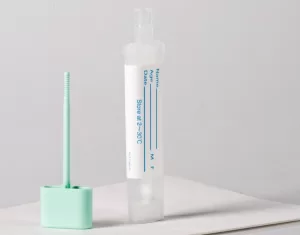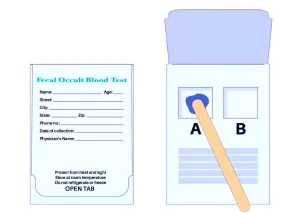The fecal occult blood test (FOBT) is a simple screening test used to detect the presence of blood in the stool that is not visible to the naked eye. It’s an important tool for the early detection of colorectal cancer.
In this post, we will discuss how to perform the FOBT at home, what the results mean, and what you should do next.
I. What is colorectal cancer
Colorectal cancer is a tumor that grows in your colon or rectum. It’s the 2nd most common cause of cancer-related deaths in the EEUU.
Usually, it doesn’t show any symptoms until advanced stages, which is why we try to detect it in people with no symptoms.
The best way to detect it early is through this test: fecal occult blood test (FOBT).
Colorectal cancer can cause minimal bleeding into our stools, but it is so small that we can’t really see it. Fortunately, this technique can detect it.
II. What is a fecal occult blood test (FOBT)?
The FOBT is a non-invasive, low-cost screening test that detects the presence of blood in the stool.
It actually detects “hidden” blood – blood we cannot see.
If you do see blood in your stools, you probably have hemorrhoids or something similar.
Occult blood, on the other side, is usually a sign that there is something bleeding deep inside, like a polyp or cancer.
Because we can’t see it, we need to rely on chemical reactions. The FOBT has those chemicals inside.
This test will tell us whether there is occult blood or not, but it won’t confirm the presence of cancer.
If you get a positive (+) result, you will need additional tests like colonoscopy.
III. Who needs a fecal occult blood test (FOBT)?
We use FOBT for people over 45 with no symptoms.
However, if you have symptoms like:
- constipation
- weight loss
- fatigue…
…then you don’t need FOBT. In that case, you need to go to the doctor (and maybe a colonoscopy).
IV. Types of tests and how to take the samples
There are 3 variants of the test:
- Immunochemical fecal occult blood test: you’ll get a small stick and a bottle/container. You take a small sample of your stools and place it inside the container.
This is the best method because it’s the most accurate, and you don’t need to change your diet the days before.

- Guaiac fecal occult blood test: some cards where you have to apply a smear of your stool into some squares. You do this on 3 different days and take the cards to your doctor/health center. You need to adapt your diet during the days before.

- Flushable reagent pad: a pad you have to throw inside the toilet after you poo. Then, you wait to see if it changes color and write down that color. You do not have to recover the pad; just write down the color. Repeat this 3 different days and send the results to your doctor (your notes with the results, not the pad).
V. How to prepare for the fecal occult blood test
The preparation depends on which test you are having.
· If you are using the “guaiac” or the flushable pad, then you need to watch your diet. 3 days before the test, you need to avoid lemons, oranges, or vitamin C supplements. You also need to avoid red meat.
· If you are using the immunochemical test, you don’t have to change your diet.
You also have to avoid some drugs for 7 days, no matter what test you use. Stop taking non-steroidal anti-inflammatory drugs such as ibuprofen, naproxen, or aspirin.
However, if you are taking aspirin to prevent a heart attack (as an antiplatelet drug), you must ask your doctor first before changing anything. Don’t stop taking it by yourself.
VI. Limitations
The FOBT is a screening test, not a diagnostic test.
Like all screening tests, it has limitations. For example, it has “false positive” cases and “false negative” cases.
That means you can have a positive test and not have cancer. And the opposite: you can have a negative test and still have cancer, even though it’s not that common.
That’s why, after a positive result, you need more tests to confirm or exclude cancer.
So, can it be something other than cancer?
Yes, there are many other things that may cause bleeding, like polyps, hemorrhoids, inflammatory bowel disease, ulcers…
VII. What comes after the test?
If the results are negative, then that’s it. You don’t need to do anything else.
If the results are positive, you’ll need more tests.
Usually, you’ll get a colonoscopy because it shows your colon from the inside so we can check if there are any polyps or tumors. Also, it allows us to take samples.
If you are over 45 years old, ask about the fecal occult blood test and do it. It’s the most effective way we have to detect colorectal cancer before it’s too late.
Leave a Reply